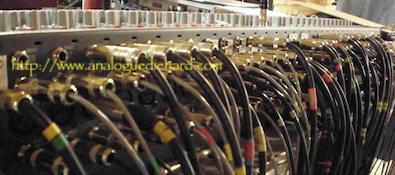
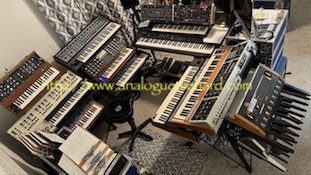
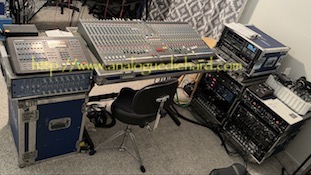

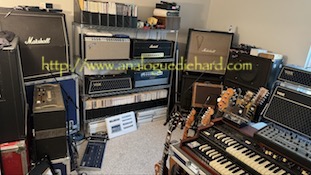
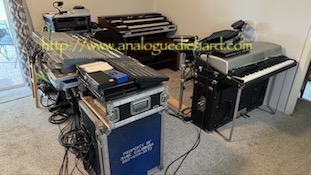
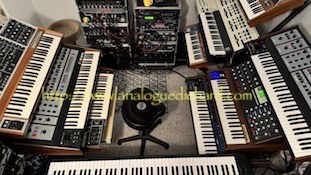
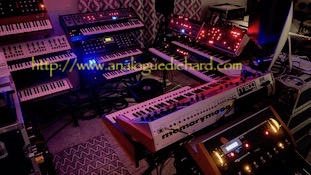
 |
 |
 |
 |
 |
 |
 |
 |
| Mixing Station |
Hammond/Rhodes/Drums | MIDI Station |
Racks |
Epilogue |
| 1995 |
2001 |
2003 |
2004 |
2004 |
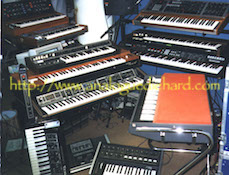 |
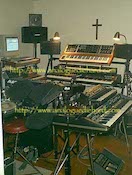 |
 |
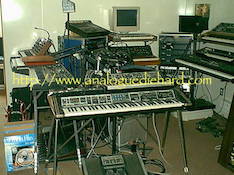 |
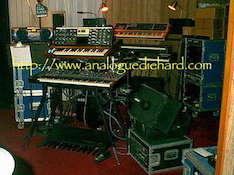 |
| 2000 |
2009 |
2010 |
2011 |
2014 |
 |
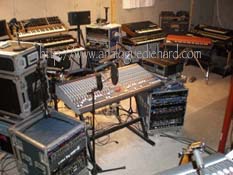 |
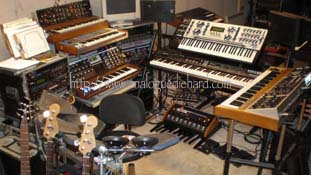 |
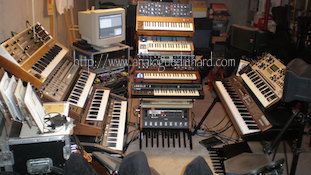 |
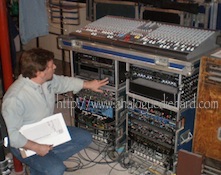 |
| 2016 |
2016 |
2016 |
2016 |
2016 |
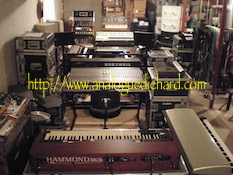 |
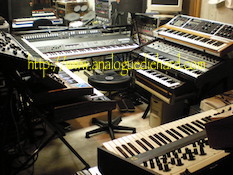 |
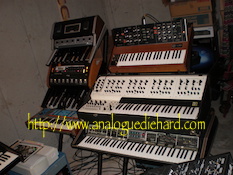 |
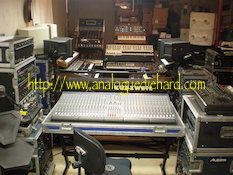 |
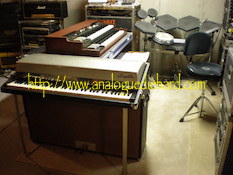 |
| The speakers swivel on the
poles so I can use them either at the mixer, the MIDI drums,
or the keyboards. Another goal was to maintain a low height
profile with all the gear so that the sound field from the
monitors was not interrupted. My studio monitors are
Control-5s with companion subwoofer. Yes they're ancient but
they have served my needs well and I have no compelling
reason to replace them (unless replacement drivers or
speaker cones are no longer available). There's racks on each side with FX; compressors, digital reverbs, EQs. Hard disk recorder is Alesis HD24 and it can be controlled over MMC from my sequencer computer. The A&H mixer has proven to be very versatile for the $$$, and almost all 40 channels are used (a 24 track recorder does not equal a 24 channel mixer). By keeping the height profile of racks to the sides low, the sound field from the monitors is not interrupted. I had initial concerns about reflections off the wall but it wasn't a problem. It's a good sounding arrangement. To minimize ear fatigue during extensive sessions I keep the monitor volume low. The JBL monitors are near field monitors that are designed for accurate reproduction but not projection - you don't use these to blast sound across the room. |
 |
| I occasionally gig the Hammond
XK3c/XLK3 so the assembly rests in the lower lid of
its Anvil case, ready to go. I prefer not to gig the Rhodes
- it is an older 1967 model with original Raymac tines that
sound great but they don't hold their tuning when bumped
around. The MIDI drums is a hodgepodge of drum pads (Roland,
Dauz, Simmons, Drum Workshop, Acupad aka Hart Percussion,
etc) that I acquired over the years. I am a drummer and
there are times when a pair of sticks gets a more realistic
performance than a MIDI keyboard. When I need to lay down drum parts on the MIDI drums, I can use the monitors from the mixing station. Another reason the monitor volume is kept low is that drums played too loud can blow the monitor drivers (yes it HAS happened). top |
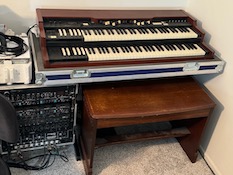 |
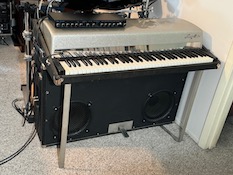 |
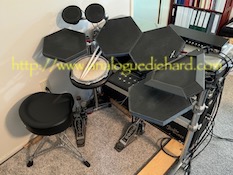 |
| The master MIDI controllers (Kurzweil
MIDIBoard and Oberheim XK)
transmit MIDI to all the MIDI devices and to the MIDI
sequence computer, which is immediately to the right.
There's a tier above is that isn't specifically reserved for
anything - I can use is as a music stand for wide scores or
for modules or for another keyboard which is infrequently
used (like my Korg DSS-1 sampler).
Both sides are flanked with keyboard stacks and they all
have MIDI retrofits. There was no way I could arrange all my
keyboards from a central location so I reserved those
positions for the ones with deep feature sets or those I
frequently tweak so they are convenient. The sitting area looks cramped, but it really isn't. Even the stool is comfortable there, although there's only room for one person in that setup. From the sitting position the MIDI controller is comfortable, the monitors are pointed right at my ears (permitting low volume), the computer monitor is at eye level, I can reach all the boards to the side comfortably, and there's no more back strain! All the synths/modules in this area have MIDI (the vintage ones have retrofits). They include the Oberheim OB-X8, Moog Voyager, Oberheim OB-SX, ARP ProSoloist, Oberheim OB-X, Moog Memorymoog, Oberheim FVS, Moog Minimoog, Moog Source, Kurzweil 1000 ROMplers, Sequential Trigon-6, Oberheim OB-X8 module, Moog Taurus, Moog Taurus III. |
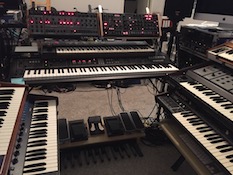 |
 |
| There's a sliding tray under
the ARP ProSoloist
on the right with the keyboard and mouse for the MIDI
sequencer computer. I build my parts on the sequencer then
record audio of each synth/module to the hard disk recorder.
The sequencer can sync to the hard disk recorder via MIDI
MMC so I have remote control of the HD24 from the keyboards,
or remote control of the sequencer from the mixer. MIDI
computer system is an Apple iMac and a MOTU micro express
USB MIDI router. Another key component is the JLCooper MSB+
MIDI patchbay, which can configure the MIDI routing
from where I am working. I can control any area from any
location. My keyboard racks contain ROMplers, line mixers, effects processors, and EQ/power amp for the monitors. Locating the racks for easy access while sitting at the MIDI controller required some compromise as some had to sit close to the floor. I chose to place the Kurzweil ROMplers close to the floor as I seldom needed to edit those sounds anymore and they are completely MIDI controlled. The power amp and EQ never needs touching other than power on/off. So my effects processors sit at accessible height because I tweak those often. On top of the rack drawers, the universal effects racks to the right of the MIDIBoard doubles as a stand for my iMac. |
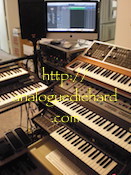 |
|
| The keyboard stands on the
sides close to the MIDIBoard are the short 48 inch
Standtastic stands with three tiers on each. I have tried
many keyboard stands and the Standtastic is the most
flexible and rugged model I have found. Standtastics are
best for a fixed location, others are better for quick
teardown/setup for stage work. My stage keyboard stands are
Bespeco (now K&M) and even then I had to modify them to
fit my needs. The MIDI controllers sit on the one and only Ultimate stand I will ever own; it initially was my sole keyboard studio stand in an "A" frame format (see the 1995 picture), but the tubular tiers proved to be unreliable as they were not secure enough - one morning I found my Memorymoog on the floor from a five foot drop due to a loose tier (!!!). You can't tighten the clamps for the tiers for risk of splitting them, so there's no way to reliably secure the tiers from rotating. Ultimate are my least favorite keyboard stands. I re-configured the stand so it is a solid table support for the heavy/bulky MIDIBoard (which no longer "bounces" when I pound it like a piano), and as a bonus the vertical poles served as mounting posts for the studio monitors - right at ear level when I sit at the MIDIBoard. |
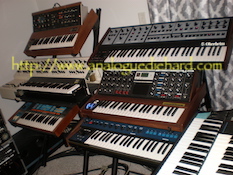 |
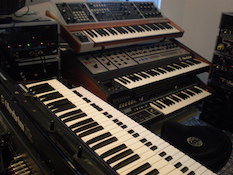 |
| The synths behind the MIDI
station. These either have shallow feature sets that don't
require much editing, or were impractical to place at the
MIDI station. It was a compromise but it works. I
chose to use the tall 60 inch Standtastic keyboard stands
here, but only used three tiers instead of five. That was
driven by the size of the instruments. Underneath them is the companion subwoofer for the JBL monitors. In the old setup they were too close to my listening perspective and I couldn't hear/feel the low frequencies due to longer wavelengths unless I stood back a distance (and I like bass). With them placed at the extreme end of the arrangement, now I can hear/feel the bass as they are far enough for the wavelengths to develop. That makes a difference at both stations. The Oberheim FVS is a recent acquisition, awaiting restoration. The FVS is hardly a shallow feature instrument, but it is so frigging big that I couldn't stack anything above it up at the MIDI station without interrupting the sound field. The only practical place was behind the MIDI station. I have a surplus Highly Liquid UMR2 MIDI retrofit (now sadly out of production) that will only enable MIDI note on/off for the FVS keyboard but there is little else in the FVS that can be MIDI controlled. However the UMR2 will work over a 64 note range which extends the 49 note keyboard of the FVS. Since the FVS is only 25% programmable it does require extensive editing so I arranged it for use while standing up. It's an instrument that gets a lot of unique sounds and is lots of fun to experiment with. An original RAM Minimoog with Lintronics MIDI retrofit is above the FVS. Unlike the MIDI retrofit on the Source, the mod wheel can be controlled over MIDI on the Minimoog. The Source still serves as a good bass synth; it may not have the solid fundamental of the Taurus pedals but it has features like variable pulse width/triangle waveforms and full ADSR EGs that get bass sounds the others can't. It has the Encore Electronics MIDI retrofit, I was one of their first customers when the retrofit was introduced in 1991. The Source is very good at fat synth leads but the MIDI retrofit doesn't control the mod wheel. When I want a stereo bass/ostinato synth sound I favor the Source through the Korg SDD-1200 which is a normalled signal path in my patchbay. The first polyphonic synth I owned since 1985 is my Polymoog; I don't use it much anymore (it can't be MIDI'd). But it is the only instrument I am sentimental about, so I converted it to a coffee table with a tempered glass top in my living room. |
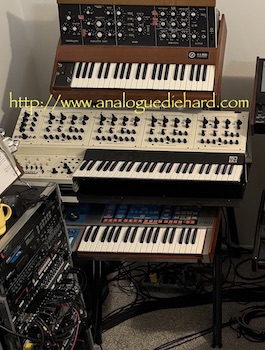 |
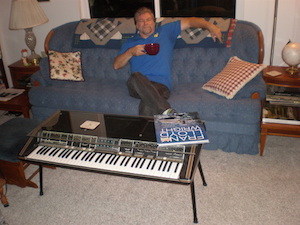 |
| The Taurus pedals
were never comfortable on the bottom tier near the floor in
the old setup. This time around I tried to place them up at
the MIDI station on the floor to the sides but that wasn't
practical. I thought "can a set of tiers be installed on the
back of the Standtastic stand" and by golly you can!
No I can't play them with my feet, and no I don't care. I
can play them with my hands or from MIDI. Because of
their shallow feature set, not much editing is needed on
them so their accessibility is good there. |
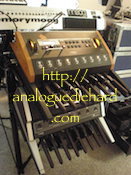 |
 |
| I have a Moog Taurus II
bass pedal controller underneath the MIDIBoard that is
retrofitted with a MIDI interface so I can play the Source
or Taurus pedals or any MIDI instrument from the MIDI pedal
controller. I wish I had retrofitted them years ago,
it is loads of fun playing synths with both my hands and
feet. I built an A/B switcher and stepped attenuator for the studio. The switcher controls whether the audio from keyboards is routed to the MIDI station or to the mixing station, and whether the studio monitors receive signal from the keyboards or the mixer. This is useful wherever I am positioned, IE if positioned at the mixing station the MIDI sequence computer plays back the keyboards while I am balancing playback from the hard disk recorder. More details here. |
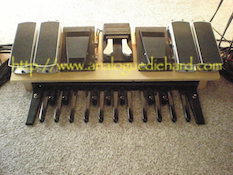 |
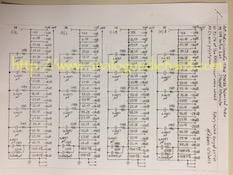 |
| Cabling... the necessary evil of recording
studios. I have built my own audio and MIDI cables for
over 40 years, and have settled on raw cable, plugs, and
jacks with proven reliability. This is vital because
the last thing I need during a precious moment of
inspiration is hunting down a defective cable. I tried
OTS cables but they proved to be unreliable. Long ago, I settled on a convention of select cable lengths - 25ft, 15ft, 9ft, 6ft. Never use custom length cables - a friend did that with his studio, and when he attempted to re-organize the room he had piles of too-short cables that couldn't be used anywhere else! Another necessary evil of studio are I/O panels and patchbays. I design and build my own I/O panels for my racks, which typically include inlets/outlets for AC power, audio jacks, MIDI jacks. Patchbays are used for routing audio and for normaling standard routings. I never liked adhesive backing on labels, the sticky residue they leave behind can be a challenge to remove especially when studio arrangements change! I opted for magnetic labels on the channels instead of adhesive labels. I made point labels using card stock paper (or business cards flipped over with the blank side on the back) attached to business card magnets; I cut them to size then apply them to each channel. On each label I use a color labeling convention that tells me which whether the point is input (blue) or output (red) - quick glance eliminates guesswork. |
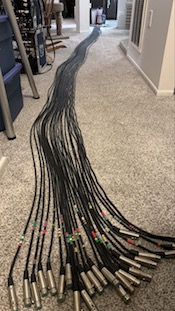 |
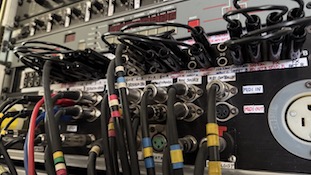 |
| Accessories, accessories, accessories.
Stored in rack mounted drawers. Various cables, DI boxes,
etc are kept in these. Above them are the universal
effects racks for my analog polysynths and the MIDI
computer. Sometimes I will record a band for a demo. I bought this ProCo 150ft snake a long time ago for my stage PA system; since I moved south I really have no further need as the majority of live music venues are small. So the snake is now used for audio runs outside the studio area for a live band; the living room, the garage, or the screened in porch. Luckily the snake has excellent capacitance per foot rating, meaning that there is no signal loss over the entire 150 feet of snake cable. |
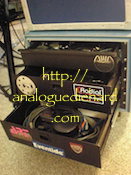 |
 |
| Starting in 2005 I've collected an impressive
array of professional audio processors. One of the
first ones is the Eventide 2016
digital reverb. I swore off menu interfaces with
LCDs, and this box has a panel full of controls for
configuring the reverbs. The 2016 is a unique
processor that sounds like no other; it is a modern remake
of the famous SP2016 which has long been favored for its
ROOM algorithm on drums. It sounds excellent on vocals
and other instruments too. The 2016 only has room and
plate algorhitms but they are highly effective. Very
good ambient reverbs that has an uncanny talent of "lifting"
a signal out of a busy mix without turning it up. I
like the radial LED indicators integrated in the front panel
endless encoders for a quick visual review of the presets. Below that are my UREI LA-22 dual channel frequency selective compressor/expander units, which are real problem solvers. I don't know of another hardware product with the same features. They can change a dog of a snare or kick drum into a monster. I was doing post processing on a live recording, and when the guitar player turned on his talkbox it would squeal a lot into his microphone. Only the LA-22 could tame that squeal without changing the tone of the guitar. I have to leave an empty 1U rack space above them because they generate a lot of heat. The JBL/UREI 7110 compressor below them is the granddaddy from which the LA series are derived from (I have a 2nd one for stage use). This has the optional Jensen output transformer that improves the fidelity, I reserve this for bass guitar or acoustic guitar. The 7110 and LA units include both a peak and RMS detector which can be blended to the audio control element. With the right blend the compressor sounds very natural. The Korg SDD-1200 is a dual digital delay that do modulated delays and has a generous rear patch panel. Great for stereo modulated delays (chorus, flanging), ping pong delays, doubling (REALLY good on toms). Does not alter the original signal one iota. The Yamaha E1010 below that is a simple delay which is not the greatest for modulated delays or the best fidelity, but it found a home for Haas processing of guitars, etc. The delayed signal has a different tone than the original which makes doubling sound more realistic. Sometimes imperfections can be a good thing. Finally we find the Moog Parametric Equalizer, which is one of the best ones ever made. Not an EQ I use for color, but my tool for surgical EQ. I had a live mix where the resonance of the snare drum was interferring with the vocal so I applied a mild notch at the offending frequency. As far as I know, this is the only parametric EQ with +/-20dB boost/cut (the renowned Massenburg parametric EQ isn't that steep). A 20dB notch on this thing can really kill an offending harmonic. The jacks on the I/O panel for each processor includes a TRS jack that interfaces with the insert on mixer channels, and separate input/output jacks for chaining processors. |
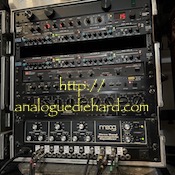 |
| Drawmer makes the best gates on the planet -
they just WORK. The classic DS-201 dual gate
is paired the DS-404 quad gate.
I'll reach for the DS-404 for the simple gate tasks, and
reserve the DS-201 for real problem signals. I have
used them on drums, vocals, and live horns to minimize bleed
from surrounding noise (I don't have isolation
booths). They are excellent for post processing of raw
recordings of live music, where bleed is a constant.
Tunable gates work very well to block a snare drum leaking
in the kick drum mic. The Drawmer DL-231 is a dual channel gate/compressor/limiter all in one. The gate (termed "expander" in this unit) is a much simpler affair than the DS units but they include an insert for frequency selective gating. Most compressors have peak or RMS detectors; this thing has log detectors which happen to be very effective on percussion/kick/snare. I had wanted a Lexicon in my arsenal so I chose the Model 200 because it is from the "legacy" era of Lexicon reverb algorithms and it has a panel full of knobs and switches for configuring the reverbs (no menu, no LCD). Luckily this is not redundant with the Eventide 2016. The Model 200 has algorithms for halls, plates, chambers, rich plates, splits, and inverse. When I want long reverbs I reach for this box. Everything from the Boston Symphony Hall to the Houston Astrodome. I used this box to reproduce a lovely "bloom" of a venue we played - when the drummer banged on his floor tom, it triggered a nice resonant reverb. I had to duplicate that. Hard to make a bad sound with the Lexicon or the Eventide. Pitch shifters are a necessity so I acquired the Eventide H969 "harmonizer". This is the peak of Eventide pitch shifting using discrete logic without a CPU (it does contain a CPU but it is used for the front panel not audio processing). Very intuitive front panel controls (no menu, no LCD), you press one button for chromatic pitch intervals. Also includes other processings like doubling, flanging, delay, doppler, reverse, repeat. This box will make two singers sound like a crowd. The last device is a Moog ten band graphic equalizer. Nothing exotic or "surgical", but when using boost it has a colorful sound. |
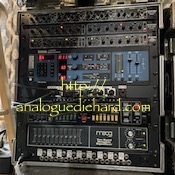 |
| This rack serves a dual purpose in studio or
on stage. It has components that are optimized for
vocals and drums. Top device is an Eventide 2016
digital reverb for vocals. These retail for
$2000 and believe me they are well worth it (I now own
three). I find that short ambient reverb is very
effective on vocals, and this box has an uncanny talent of
making the vocals get heard in dense guitar-heavy live music
without turning up the mixer channels. Underneath the
2016 is a Korg SDD-2000
digital delay, also used for vocals. The Korg unit is
delay only (max 4096ms) but it is programmable which is
quick work when changing sounds at a gig. I programmed
delay times of prime numbers, with the output level
inversely proportional to delay time. The half rack
width device under the Korg is a Rane FAC24
crossover which I use as a highpass filter on the output of
the Korg, which rolls off bass which makes the echo sound
more natural and avoids mud with too much bass. Moving further down we find my drum processors. The Drawmer DL231 dual channel compressor is used on kick and snare. It is unusual in that the detector is a log type, which happens to be very effective on percussive sounds. Under the Drawmer is a Lexicon PCM-60 digital reverb for the snare. It's a different reverb quality than the 2016 but sounds great on snare, and a good "quick change" device. The next two are a pair of UREI LA-12 dual channel compressors for vocals. No single compressor works for everything, and these LA-12s give me four channels of compression that sound "transparent" when dialed in right - perfect for vocals. The EV EX18 stereo crossover underneath the UREIs is used as a high pass filter to roll off bass on the drum overhead mic (which blocks off stage bleed from nearby guitar amps) and on the vocals. The final device is a Tascam CD player for playing music during breaks. |
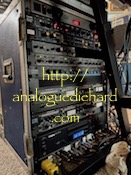 |
